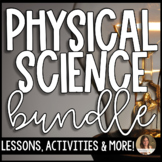Physical Science Task Cards Bundle - Editable and Self-Grading Google Forms
- Zip
- Google Apps™

What educators are saying
Products in this Bundle (13)
showing 1-5 of 13 products
Also included in
- Save over 20% with this resource that includes all of my physical science activities including PowerPoints, Guided Notes, Assessments, Warm Ups, Self-Grading Task Cards, Choice Boards, Interactive science notebook Google Slides and Print Activities, Labs, Stations activities, project-based learningPrice $266.00Original Price $332.50Save $66.50
Description
Each set of Physical Science task cards includes:
24 editable task cards can be used in a classroom or digitally for distance learning through Google Forms with self-grading! They can be easily printed, cut and laminated for use in the classroom with a ready-to-print student answer sheet.
*** This is a growing bundle! Each time a new set of task cards is added, the price will increase. After purchasing, you will have access to any added set of physical science task cards at NO cost! ***
The link for Google Forms is available in the resource. Answer keys are included in the resource and in Google Forms. Students will instantly get their grade after completion of the task cards in Google Forms.
Task cards can be printed 1 per page or 4 per page. The answer sheet can be printed 1 per page or 2 per page to save paper. I typically print 2 per page so they're perfect for gluing into interactive notebooks.
The text is editable in each task card but the titles and clip art are not editable.
1. Scientific investigations and Inquiry
Content covered:
⭐ Experiments vs Observations
⭐ Creating a Hypothesis
⭐ Variables (Independent, Dependent, Constant)
⭐ Data (qualitative vs quantitative)
⭐ Scientific Method Steps
⭐ Repetition vs. Replication
2. Energy Mass, Volume and Density
Content covered:
⭐ Matter
⭐ Mass
⭐ Weight
⭐ Volume
⭐ Formulas as well as calculating mass, volume and density
⭐ Water displacement
3. Physical and Chemical Changes
Content covered:
⭐ Physical properties (mass, weight, volume, density, malleability, thermal conductivity, electrical conductivity, solubility, magnetism, luster, viscosity)
⭐ Chemical Properties (reactivity, flammability)
⭐ Physical changes
⭐ Chemical Changes
⭐ Law of Conservation of Mass
4. Energy Forms and Transformations
Content covered:
⭐What is energy?
⭐Types of Potential Energy
⭐Types of Kinetic Energy
⭐Energy Transformations
⭐Law of Conservation of Energy
5. Thermal Energy and Heat
Content covered:
⭐ Thermal Energy
⭐ Temperature
⭐ Heat
⭐ Conduction
⭐ Convection
⭐ Radiation
6. Forces and Motion
Content covered:
⭐Motion
⭐Speed
⭐Calculating Average Speed
⭐Velocity
⭐Acceleration
⭐Balanced & Unbalanced Forces
⭐Contact Forces
⭐Forces at a Distance
⭐Newton's Laws of Motion.
➾Graphing velocity, average speed or acceleration is not included.
7. Pure Substances and Mixtures
Content covered:
⭐ Pure substances
⭐ Elements
⭐ Compounds
⭐ Mixtures (heterogeneous, homogeneous)
⭐ Solutions, colloids and suspensions
8. Atoms and the Atomic Theory
Content covered:
⭐ Atoms
⭐ Atomic Structure and subatomic particle masses
⭐Contributing scientists to the atomic theory (Democritus, Aristotle, John Dalton, J.J. Thomson, Ernest Rutherford, Erwin Schrödinger and Werner Heisenburg)
⭐ Isotopes
⭐ Atomic number
⭐ Mass number
9. Changes in States of Matter
Content covered:
⭐ States of matter (solid, liquid, gas)
⭐ Kinetic Theory of Matter
⭐ Thermal Energy
⭐ Changes in states of matter (Boiling, evaporation, condensation, melting, freezing, vaporization, sublimation, deposition)
⭐ Pressure and Temperature
10. Periodic Table
Content covered:
⭐ What is the Periodic Table?
⭐ How to obtain information from the periodic table.
⭐ Dimitri Mendeleev and Henry Mosely.
⭐ Chemical name, chemical symbol, atomic number, average atomic mass.
⭐ Groups and periods.
⭐ Metals, nonmetals and metalloids.
⭐ Arrangement of elements.
⭐ How to determine if elements have similar properties.
11. Interactions of Light Waves
Content covered:
⭐ Transparent, translucent, opaque
⭐ Reflection, refraction, absorption
⭐ Absorption and reflection of color.
12. Properties of Waves
Content covered:
⭐ What is a wave?
⭐ Transverse and longitudinal waves
⭐ Mechanical vs. electromagnetic waves
⭐ Parts of transverse waves
⭐ Parts of longitudinal waves
⭐ Wavelength
⭐ Amplitude
⭐ Frequency
13. Electromagnetic Spectrum
⭐ What is electromagnetic radiation?
⭐ What is the electromagnetic spectrum?
⭐ Radio waves
⭐ Microwaves
⭐ Infrared
⭐ Visible Light
⭐ What determines the color of light?
⭐ Ultraviolet
⭐ X-rays
⭐ Gamma Rays
⭐ what role does the sun play?






